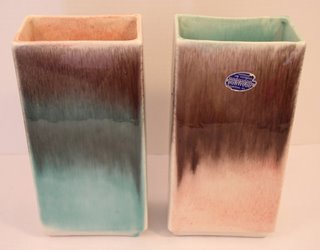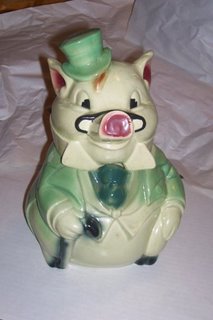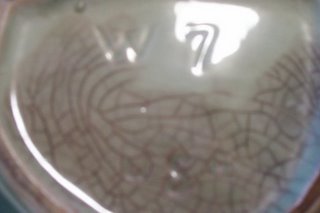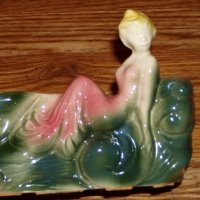
Gary writes:
Hello I was trying to id this pottery I have, I've seen one in a antique store like it they said it was McCoy, do you know what maker it is? Or is it McCoy? I would appreciate any help you could give me.
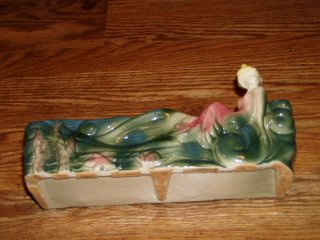
Hi Gary, it's not really McCoy, but Brush (a/k/a "Brush-McCoy"). It's not unusual for people to mix up the companies, because there were 4 generations of McCoys working in the pottery business in Ohio. The following information comes from the McCoy Pottery Collector's Reference & Value Guide by Hanson, Nissen, and Hanson, and The Guide to Brush-McCoy Pottery by Martha and Steve Sanford. So here's the story of Nelson, WF, JW, George, Nelson, Nelson, and Nelson.
In 1848, brothers W. Nelson McCoy and W.F. McCoy formed a pottery business in Zanesville, OH. They made stoneware crocks and jars.
In 1899, W. Nelson's son, James William McCoy, started the J.W. McCoy Pottery company in Roseville, OH.
In 1909, George S. Brush (who founded the Brush Pottery Company in 1906 in Zanesville) became J.W. McCoy's general manager.
In 1911, the two potteries merged to become the Brush-McCoy Pottery company. J.W. McCoy continued to be a principal stockholder until 1925, at which point the company was renamed Brush Pottery.
In 1910, Nelson McCoy (J.W.'s son), along with help from his father, formed the Nelson McCoy Sanitary Stoneware Company in Roseville, OH. Nelson McCoy's wares competed directly with those manufactured by Brush-McCoy. In 1933 this company reorganized to become the Nelson McCoy Pottery Company. After Nelson McCoy died in 1945, his nephew Nelson McCoy Melick became president, and remained president until his death in 1954. At that time, Nelson McCoy Jr. became president. In 1967 the pottery was sold to Mount Clemens Pottery Company, and in 1974 it was sold to Lancaster Colony Corporation. Nelson Jr. remained president throughout that entire time and the pottery was still known as "McCoy." Nelson Jr. Left in 1981, the pottery was sold to Designer Accents in 1985, and they were out of business by 1990. Pottery from this NelsonX3 company is what is known to collectors as "McCoy."
So, on to your planter. It is a #912 garden dish that was made in 1956. Brush made a whole line of garden dishes like that in the 1950's: the ones I see most often are a bear, raccoon, or squirrel on a log, but there are others with seahorses, puppies, birds, etc. Not only is the paint style and quality similar throughout the line, but the real give-away is the bottom of the planter: all of the planting dishes I have seen from that line have the same pattern of unglazed rails on the bottom: turn it on edge and it's shaped like an "E" or a "3."
Sanford's Guide to Brush-McCoy Pottery Vol II lists the value as $60-70 (1997 price guide). Their values tend to be a bit high (especially since I live in the Midwest), and I think the greater availability of stuff on eBay has pushed pottery values down even further. The same authors list the bear or raccoon on log from the same line as $50-60, but I see these in antique malls here in the Midwest for around $12-25. There are several of the animal-on-log planting dishes for sale on eBay right now (search for "log" under Brush-McCoy pottery; there's a bear, squirrel, rabbit, and raccoon), so you might want to monitor what they sell for. Your mermaid is probably worth around 20% more than those, because it's prettier and harder to find.
